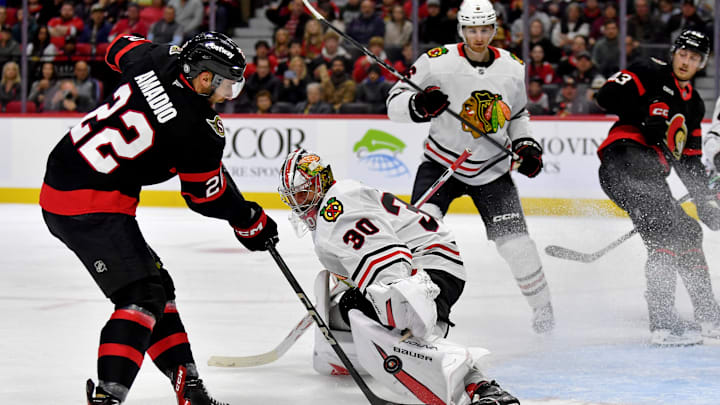The Chicago Blackhawks' last-place finish this season is due largely in part to its lackluster defense. The Blackhawks allowed the second-most goals this season while finishing 25th in the league in save percentage (.894).
Those numbers potentially paint a bleak picture for the Blackhawks, but there’s room for optimism moving forward.
Firstly, moving Seth Jones at the trade deadline was one of the savviest moves the team made. It removed an anchor from the team’s blue line. That isn’t to say that Jones was a bad player, it’s just that he didn’t want to be in Chicago anymore.
With Jones gone, the door opened for younger blueliners to step up and take charge. 23-year-old Alex Vlasic emerged as a top-pairing defenseman this season. Similarly, Louis Crevier looks poised to step into a full-time role next season, with first-round pick Sam Rinzel and Wyatt Kaiser also vying for full-time jobs this upcoming season.
Yes, having a young blue line means dealing with growing pains, but there’s room for optimism heading into next season. After the calendar turned to 2025, the Blackhawks were 13-22-9. They were outscored 163-129 for a minus-34 goal differential, according to StatMuse.
But after the trade deadline, the Blackhawks went 6-11-3 with their goal differential down to minus-23. Despite the seven-game losing streak following the trade deadline, the numbers reflect a potential defensive improvement.
So, how do the Blackhawks continue building on their defensive improvements?
The question lies in cutting down on shots against.
Chicago Blackhawks' defense must cut down on shots against
The Chicago Blackhawks need to cut down on the number of shots against. It’s essentially that simple. The Blackhawks finished third in the league in shots against with 2,551. The Anaheim Ducks and San Jose Sharks topped the list. In comparison, the Carolina Hurricanes gave up the least amount of shots in the league with 2,011.
If we maintained the Blackhawks save percentage at .894, but simply reduced the number of shots to say, 2,106, the number of shots 15th place Calgary surrendered, the Blackhawks would theoretically give up 222 goals throughout the season (2,100 shots multiplied by 10.6%, the opponents’ shooting percentage).
That total comes to 2.65 goals per game. That goals-against average would be good enough to land the Blackhawks between the fourth-place Tampa Bay Lightning (2.61 GAA) and the fifth-place New Jersey Devils (2.68 GAA).
Just by reducing the number of shots on goal, the Blackhawks wouldn’t need to substantially improve goaltending. Goaltenders can perform equally to what they did this season. The difference lies in the number of shots they would face throughout the course of a game and a season.
Now, it’s worth noting that the Blackhawks need more blueliners like Connor Murphy. Murphy was 17th in the league with 160 blocked shots. In comparison, the NHL’s leader in blocked shots this season, Ian Cole of the Utah Hockey Club, stopped 211.
If the Blackhawks can focus on blocking more shots next season, their shots on goal could dramatically decrease. In turn, their goals-against average could plummet, leading to an improvement on defense.
So, the potential is there for the Chicago Blackhawks defense to go from a liability to a strength next season.
